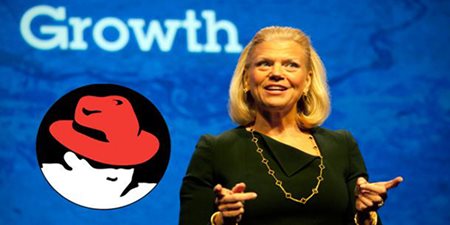IBM Makes Huge Investment in Open Source by Acquiring Red Hat
By Laura Myers
November 2, 2018
acquisition, Cloud, Cloud Computing, Cloud Marketing, Enterprise Cloud, Hybrid Cloud, IBM, open source, Red Hat, Software
On October 29th, IBM announced it would be acquiring veteran open-source software vendor Red Hat in  “a deal aimed at helping the company boost a cloud computing business central to reviving the tech giant”, according to the Wall Street Journal.
“a deal aimed at helping the company boost a cloud computing business central to reviving the tech giant”, according to the Wall Street Journal.
Many know IBM has been feeling a bit left in the dust by competitors like Amazon, Google, and Microsoft who have pulled ahead into almost their own race in the enterprise cloud computing market. Following the tech giant playbook, rather than spending time and resources building their capabilities from the ground up, they set their sights on acquiring the company that was already known for being a leading provider of open source software and services and as Salesforce Co-Founder and co-CEO Marc Benioff even said in his statement on the acquisition, Red Hat is “the heart of the cloud today”.
Once the deal broke, IBM made the statement that this acquisition of Red Hat, their most significant to date, would “change everything about the cloud market”. Red Hat’s $34 billion price tag makes it the third-largest in the history of U.S tech after the $67 billion merger between Dell and EMC in 2016 and JDS Uniphase's $41 billion acquisition of SDL in 2000. While the deal still awaits approval from shareholders and regulators, it is expected to close in the second half of 2019 with IBM taking on all of the issued and outstanding common shares of Red Hat for $190.00 per share in cash. This makes the approximately $34 billion enterprise value $13.5 billion higher than Red Hat’s market capitalization of $20.5 billion before the acquisition.
What Does This Acquisition Mean?
While IBM feels this acquisition is significant, it’s not unique. CNBC highlights there has been an apparent open source theme in technology acquisitions this year. Before IBM's purchase of Red Hat hit the news, Microsoft’s acquisition of GitHub ($7.5 billion) and Salesforce’s acquisition of MuleSoft ($6.5 billion) were the two biggest tech deals of 2018.
CNBC also made mention of another theme within IBM many are trying to speculate on: how long before Ginni Rometty transitions out of her position as CEO? It hasn’t gone unnoticed that in the most recent earnings update, IBM reported less revenue than expected. After a slow decline for about 5 years, IBM showed a growth spurt for three consecutive quarters but despite that, it seems most anticipate an impending exit but as Rometty told CNBC, "I'm still young and I'm not going anywhere".
It even seems like there won’t be too much of a staff shake-up within the leadership of Red Hat either. As the press release states: “Upon closing of the acquisition, Red Hat will join IBM's Hybrid Cloud team as a distinct unit, preserving the independence and neutrality of Red Hat's open source development heritage and commitment, current product portfolio and go-to-market strategy, and unique development culture. Red Hat will continue to be led by Jim Whitehurst and Red Hat's current management team. Jim Whitehurst also will join IBM's senior management team and report to Ginni Rometty. IBM intends to maintain Red Hat's headquarters, facilities, brands, and practices."
What Are People Saying?
Bringing customers over to the cloud from on-premise has never been easy and some wonder if IBM's entrance will make this new offering too complicated for the cloud. The Economist’s coverage of the acquisition dives into why IBM and Red Hat coming together may not turn out as positive as it sounds: “The question is whether the added flexibility of such mixed systems and the promise of not getting locked into any one vendor will be enough to lure firms onto IBM’s new platform. They could shy away from the additional complexity and prefer to put their data exclusively into the cloud. Microsoft, for instance, offers similar “hybrid cloud” systems, as do Dell and Hewlett Packard Enterprise (HPE), two other IT incumbents.
The merger, which is the largest in IBM's history, could go wrong for other reasons—which, in addition to the high price tag, explains why the firm's share price fell by 5% the day after the deal was announced (the company also said that it would cancel share buybacks, of which it has made generous use in recent years to prop up its shares). In particular, there could be a cultural clash between its still relatively strait-laced culture and Red Hat's freewheeling one; ties are no longer de rigueur at IBM, but suits are, whereas, at Red Hat's headquarters in Raleigh, a day's drive from IBM'S base in Armonk, it is not unusual to see employees wearing shorts (though no red hats). To avoid this, Red Hat will remain a "distinct unit", as IBM puts it.”
The cultural question is a significant consideration with any acquisition but with IBM coming into the Open Source community, you have two worlds colliding. One is a large legacy company and the other is what some view as its antithesis.
Even though IBM has some fans in the Open Source community as the founding member of the OpenStack Foundation, a set of open source software tools for building and managing cloud computing platforms, IBM “remains a large corporation with all the bureaucracy and protocols that are run counter to the spirit of open source software” says Neeraj Murarka, the CTO of blockchain startup Bluzelle Networks in his comments to Wired on the acquisition.
Murarka, who is a supporter of both IBM and Red Hat's Linux maintains the need for Red Hat to continue with its solidified brand because if not, and “IBM does not allow Red Hat to operate as it does now and maintain its culture, the values Red Hat brings to the community will deteriorate.” Looking at this acquisition through the scope of what happened even in the short time since Microsoft acquired GitHub (the large increase in the number of developers moving their projects from GitHub to its competitor GitLab), Murarka warns that could happen here as well, “The open source community is very much a decentralized space and such acquisitions are not taken very positively due to their centralizing effect.”
Ending Notes
Technically speaking, Open Source celebrates its 20th birthday in 2018 and I guess as a present the investments came rolling in. If this theme of acquisitions has taught us anything, it is what Wired stated so correctly in saying “Open Source software is free, but it certainly also seems to be worth a lot of money.” IBM making such a significant investment in Red Hat shows that yes, they needed to level up their cloud infrastructure business quickly to not get swallowed up by Amazon Web Services and Microsoft's Azure Cloud but also, gaining a foothold in that market was non-negotiable concerning the viability of their organization.

Laura Myers
A digital business, marketing and social media enthusiast, Laura thrives on asking unique, insightful questions to ignite conversation. At an event or remotely, she enjoys any opportunity to connect with like-minded people in the industry.